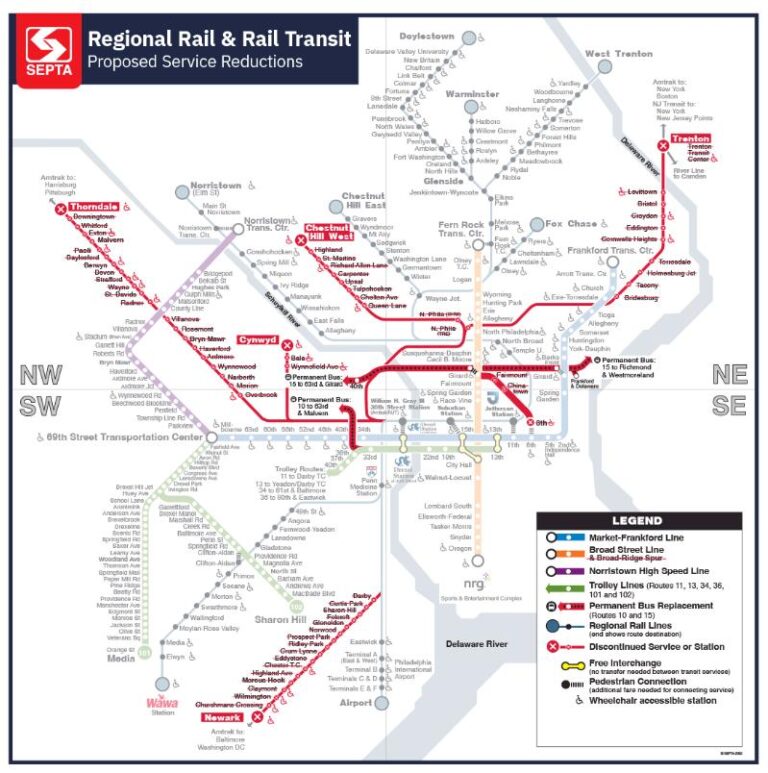Transit Challenges Affecting Student Commutes on the First Day of School
As the new academic year commenced, numerous Philadelphia students encountered unexpected obstacles due to SEPTA’s recent service reductions, which disrupted their morning travel routines. Take, for example, 16-year-old Mia and 17-year-old Jalen, whose journeys vividly illustrate the consequences of these transit changes. Mia, reliant on the Market-Frankford Line, faced overcrowded trains that forced her to wait through several full cars before boarding. Meanwhile, Jalen’s usual bus route, B343, was altered, extending his commute by approximately 20 minutes and causing him to miss part of his morning homeroom session.
These individual stories reflect a wider pattern of difficulties for student commuters this year, including:
- Reduced frequency of trains and buses during peak school hours, resulting in congested vehicles and longer waiting periods.
- Unscheduled and last-minute timetable adjustments that create confusion and missed connections.
- Insufficient communication from SEPTA, leaving many students scrambling to find alternative routes with little notice.
Such challenges not only threaten punctuality and attendance but also raise concerns about student safety and overall well-being, prompting urgent appeals for transit service improvements.
| Student | Transit Route | Issue Encountered | Delay Experienced |
|---|---|---|---|
| Mia | Market-Frankford Line | Overcrowded trains | 15 minutes |
| Jalen | Bus Route B343 | Route detour | 20 minutes |
Student Experiences Highlight Attendance and Punctuality Challenges
Marcus Johnson, a junior attending Central High School, described his first day back as fraught with delays and frustration. Due to SEPTA’s service cuts, the 42 bus line he depends on was halved in frequency during weekdays, leading to overcrowded buses and extended wait times. “I waited almost half an hour for the next bus, and when it arrived, it was packed with standing passengers,” Marcus recounted. His situation mirrors that of many students now facing longer commutes and cramped conditions, which directly impact their ability to attend school punctually and perform academically.
Similarly, Sophia Nguyen, a freshman at Roosevelt High, was compelled to adjust to a new, more complicated route after her direct train connection was eliminated. Her revised commute now includes a bus transfer that adds nearly 20 minutes to her travel time. Sophia’s experience underscores how even minor transit modifications can significantly disrupt students’ daily schedules. The table below compares their previous and current commute durations:
| Student | Previous Commute Duration | Current Commute Duration |
|---|---|---|
| Marcus Johnson | 25 minutes | 50 minutes |
| Sophia Nguyen | 30 minutes | 50 minutes |
- Greater likelihood of tardiness and absenteeism due to unreliable transit services
- Increased anxiety from having to devise alternative travel plans without guaranteed arrival times
- Financial strain on families compelled to seek other transportation options or adjust work schedules
Community Demands for Enhanced Public Transit Support for Students
Frustration among local families and students has grown as SEPTA’s service reductions have complicated school commutes, as seen through the experiences of the students highlighted above. The cutbacks in bus routes and fewer available trips have not only lengthened travel times but also increased stress for young riders. Parents and community advocates are calling for immediate measures to ensure that student transportation needs are prioritized in upcoming transit schedules and budget allocations.
Community forums have brought to light several pressing concerns, such as:
- Longer walking distances to bus stops with less frequent service
- Unsafe conditions while waiting at stops during early morning hours
- Loss of valuable instructional time due to unreliable transit options
In response, stakeholders propose a phased restoration of services combined with increased investment in safer, more efficient routes designed specifically for school commuters. The table below summarizes the key improvements requested by the community:
| Proposed Improvement | Anticipated Benefit |
|---|---|
| Expanded morning bus routes | Reduce delays and improve on-time arrivals |
| Improved shelter and lighting at stops | Enhance safety and comfort for riders |
| Dedicated student transit passes | Lower costs and encourage consistent ridership |
Strategic Investments Needed to Address Urban Transit Issues
In light of escalating transit disruptions, transportation experts stress the importance of focused investments in urban transit infrastructure to ease the burden on daily commuters. Instead of broad, unfocused expenditures, policymakers recommend targeted initiatives that prioritize vulnerable groups, including students and low-income riders who depend heavily on public transit for education and employment. These strategies emphasize upgrading scheduling systems, enhancing safety protocols, and increasing funding for agencies serving densely populated neighborhoods where delays and cancellations are most frequent.
Highlighted priorities for investment include:
- Modernizing transit fleets to minimize breakdowns and service interruptions
- Deploying real-time communication tools to keep riders informed of delays and changes
- Implementing emergency response plans for swift resolution of service disruptions
- Collaborating with schools and employers to tailor transit routes to user needs
| Investment Focus | Projected Outcome | Implementation Timeline |
|---|---|---|
| Fleet Modernization | Fewer delays and breakdowns | 1–3 years |
| Real-Time Rider Updates | Enhanced commuter experience | 6–12 months |
| Emergency Response Protocols | Quicker service recovery | Immediate |
| Route Customization | Improved access and convenience | 1 year |
Conclusion: Transit Challenges Call for Collaborative Solutions
The experiences of students like Mia, Jalen, Marcus, and Sophia on their first day back to school shed light on the widespread effects of SEPTA’s service reductions on daily commuters. While budget constraints have necessitated some cutbacks, the ongoing impact on students and the broader community reliant on dependable public transportation is significant. Moving forward, continuous monitoring of service adjustments and active engagement with riders will be vital in developing effective solutions that ensure timely, safe, and accessible transit for all users.








